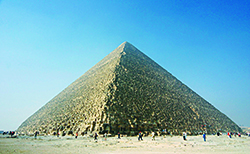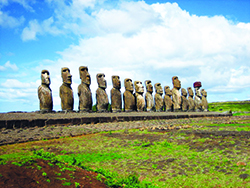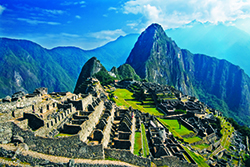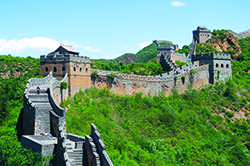All complex mechanical devices are a combination of six so-called simple machines: the inclined plane, lever, wedge, wheel, pulley, and screw. Long before industrialization, the kinetic principles behind these labor-saving tools allowed builders across premodern civilizations to build large-scale structures.
-

Great Pyramid of Khufu
Giza, c. 2500 bc
Many Egyptologists believe that workers pushed roughly 2.3 million blocks of limestone, each weighing between 2.5 and 15 tons, up an inclined plane in the form of an earthen ramp that spiraled around the pyramid’s exterior. The surface of the ramp may have been lubricated with water to reduce friction.
-

Stonehenge
Salisbury Plain, c. 3000–1520 bc
The prehistoric monument was constructed from two types of stone: bluestones, weighing between 2 and 5 tons, and sandstone boulders called sarsens, weighing an average of 25 tons each. According to one estimate, it would have taken seven hundred workers seven years to move the fifteen largest stones using logs as wheel-like rollers.
-

Ponte Sant’Angelo
Rome, 134–39
To build the durable arched bridge that stretches across the Tiber, Roman engineers constructed temporary circular barriers called cofferdams. They then used an Archimedes’ screw to pump out the water inside each cofferdam, exposing the riverbed and permitting builders to pour concrete foundations directly onto bedrock.
-

Moai
Easter Island, c. 1000–1650
Among various theories for how the hundreds of stone figures weighing 14 tons on average were erected around the island, the best-supported one holds that islanders placed the newly carved moai onto grid-like wooden sledges. Teams then propelled each sledge to its destination using wooden poles as levers, pushing the poles against the ground in a synchronized motion similar to rowing oars through water.
-

Machu Picchu
Peru, c. 1450
The stone walls of the monumental Incan city were constructed using metal wedges as chisels to shape stones into precise interlocking patterns. Each stone is held in place through friction and gravity, eliminating the need for mortar and resulting in greater stability during an earthquake, a common occurrence in the Andes Mountains.
-

Great Wall of China
China, c. 220 bc–1878
The best-preserved sections of the 5,500-mile wall, which runs from southeastern Liaoning province to northwestern Gansu province, were built in the late fifteenth century, part of an effort by Ming dynasty emperors to improve imperial fortifications. Builders employed conveyor-belt-like systems of pulleys to lift the heavy clay bricks and granite blocks used to construct new stretches and bolster older tamped-earth ones.